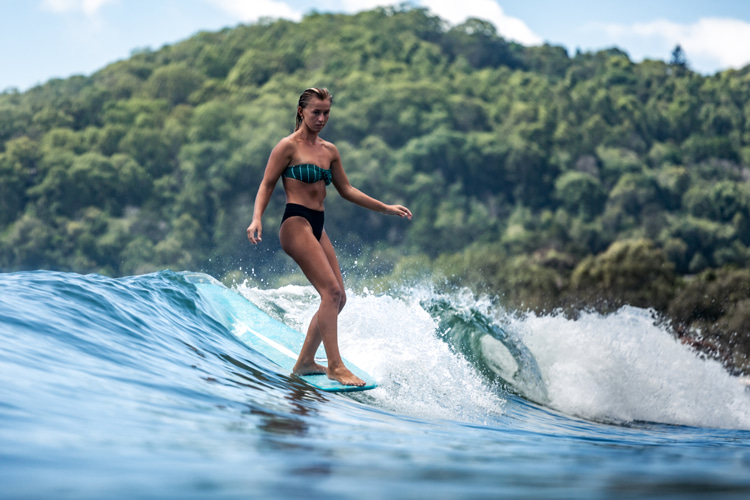The physics of surfing is an enigma.
In particular, it is unproven how a surfboard accelerates across a wave and how a surfboard can grip the water with sufficient force to allow a surfer to stand at the tip of a surfboard while riding a wave, i.e., noseriding.
In short, the wave constantly pushes the surfboard up like an upward-moving escalator.
The force generated (Force = ma) depends on the mass of water (m) accelerated (a) relative to the surfboard.
According to Newtonian mechanics, the force (Force = ma) exerted by the wave depends on the mass of water (m) pushed against the surfboard and its relative acceleration (a).
The surfboard uses this force to gain velocity and move laterally along the wave.
The surfer offsets this upward force by pointing the nose downward and allowing gravity to accelerate the surfboard down the wave.
The surfboard can balance these forces to move diagonally across the wave as the wave moves towards the beach.
In addition, the curved part of the surfboard's edge grips the water due to the Coanda effect from the wave pushing upwards against the surfboard.
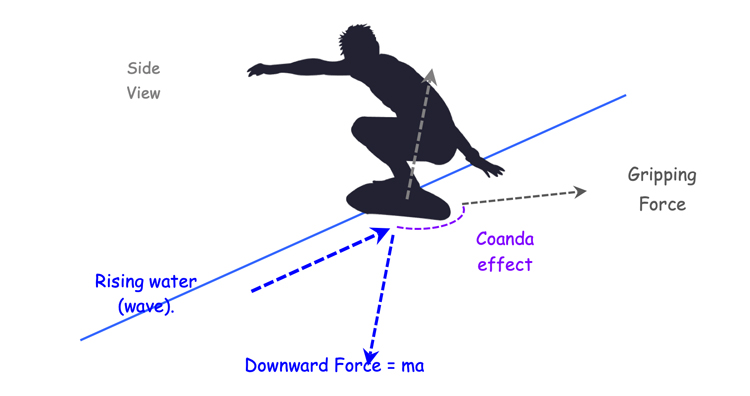
This analysis provides new and useful insights by applying Newtonian mechanics to surfing for the first time.
It is significant only to those involved in this niche sport or to people with intellectual curiosity in this area.
The explanations help all surfers - from beginners to experts - better understand the dynamics of surfing and become better surfers.
Also, it is rewarding to solve a puzzle that has eluded a solution for so long.
1. Introduction - The Theories of Surfing
There is no proven or accepted explanation of surfing supported by evidence and experimentation.
Surfing has evolved by intuition, trial, and error, which is extremely inefficient.
This situation makes it hard for a surfer to learn and select equipment, techniques, and strategies.
The discussion appears to be misguided and dominated by inappropriate concepts from fluid mechanics (i.e., Bernoulli or hydrodynamics) and other areas of physics.
It is rare to hear references to Isaac Newton, the Coanda effect, or angle-of-attack (AOA).
This paper argues that hydrodynamics can help explain fluid flow, but Newtonian mechanics explains the resultant forces involved in surfing.
The physics of surfing is similar in principle to the physics of sailing and other sports.
2. Background - Surfing
A. Wave Basics
A transverse sea wave is a vertical oscillation of the water, representing a horizontal movement of energy through the water.
The wave's upward movement is caused by water moving in a circle as the energy passes through it.
It is not accurate that only the energy moves in a wave and that water particles do not move.
The water particles do move - in a circle to create the up-and-down movement of the wave at the water's surface.
It is more accurate to say that there is no net movement of water particles over time.
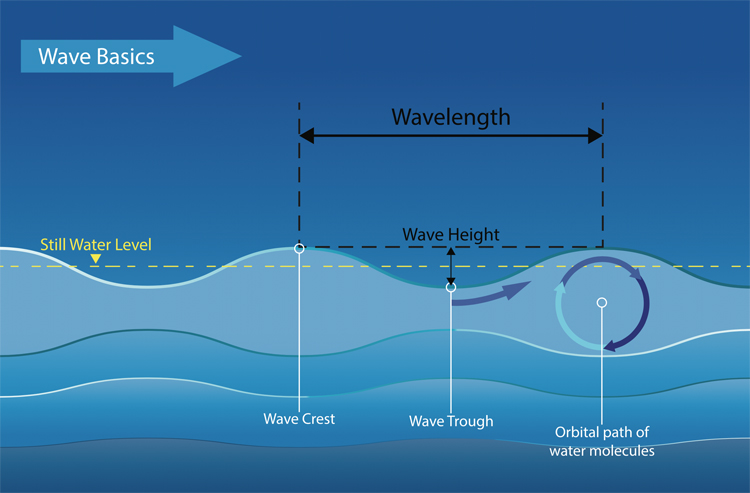
Close to the beach, the wave breaks and then recedes, providing surfing opportunities.
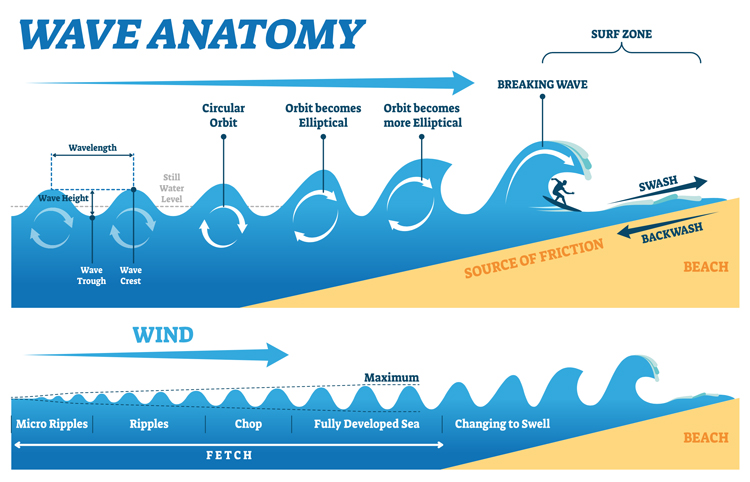
Typical features of waves include:
a) Wave direction is approximately perpendicular to the beach. The waves usually hit the beach in even lines;
b) Wavelengths, amplitudes, and speeds vary depending on the causes of the waves and circumstances (e.g., beach geography, wind, weather, etc.);
c) Surface waves are most commonly caused by wind;
As waves get closer to the beach, their amplitudes (height) increase, the wavelength shortens, the speed decreases, and their shape becomes more elliptical (compared to circular).
The increase in wave height can cause the wave to crest.
This is because the water gets shallower, and the wave's energy dissipates close to the beach.
B. Surfboard Basics
Surfboards are found in various materials, shapes, and sizes. The surfboard's length, width, fins, front tip, and back end vary a lot.
These aspects affect how water flows around the surfboard and, therefore, the forces generated.
Specifically, these aspects affect the mass of water displaced each second (m/dt) and the velocity to which this water is accelerated by the board (dv), which determine the Newtonian forces generated (Force = ma = m/dt x dv).
In turn, the forces generated affect the speed, maneuverability, and stability of the surfboard.
Surfboard materials also affect their buoyancy and interaction with the water. The size of the surfboard affects its buoyancy and how well it floats in the water.
Beginner surfers prefer large (wide and long), thick (i.e., buoyant) surfboards with a concave A-shaped underside and big fins, as these surfboards are slow and stable (e.g., longboard).
Whereas expert surfers prefer relatively small (i.e., narrow and short), thin, and unstable surfboards with tapered fonts and tails because these are fast and maneuverable (e.g., shortboard or fish).
The surfboard undersides have different shapes, which can vary across the length of the surfboard.
This affects the fluid flow around the surfboard (i.e., m/dt and dv) and, therefore, the forces generated.
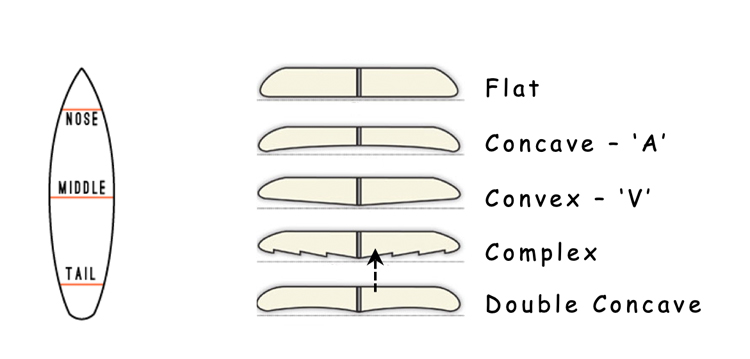
In broad terms, a convex V shape on the underside of a board adds to stability. This is because it displaces water downward toward the center of the surfboard.
Any shift in balance or orientation of the board creates forces that push the surfboard back to its original, stable position.
Whereas a concave A shape on the underside of a board adds to instability.
This is because it displaces water downward, away from the center of gravity in the middle of the surfboard.
It is the opposite of a V-shaped board.
Any shift in balance or orientation of the board creates forces that exaggerate the movement away from the board's balanced position.
This difference in board shape is similar to the anhedral (A) and dihedral (V) shaped wings of an airplane.
C. The Coanda Effect
The importance of the Coanda effect and the resultant forces generated is demonstrated by a simple classroom experiment with a spoon and tap water.
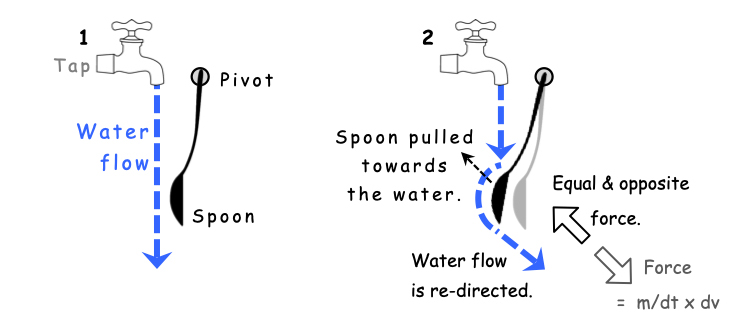
Here's the spoon experiment summarized:
If the curved side of the spoon is pushed gently into the descending water flow while attached to the pivot, then the water flow is redirected by the spoon due to the Coanda effect.
The spoon is pulled diagonally up and sideways from its original position in point (1).
The interesting point is that the spoon remains in the water flow, where it is, in a slightly raised position compared to before in point (1) above.
To put it another way, the descending water does not push the spoon out of its path. Instead, the spoon remains suspended in the water flow.
In contrast, if the spoon's orientation is reversed (so that the curvature faces the opposite direction) or if other non-curved objects, such as a knife, are placed in the water flow while connected to a pivot.
Then, these objects do not remain in the water flow and return immediately to their original position, out of the water's path downward.
These observations are only achieved if the water flow is sufficiently fast and voluminous and the spoon is sufficiently large with enough curvature.
Otherwise, the spoon does not remain attached to the water flow.
Similar experiments with curved objects, such as balls, have produced similar results.
However, the researchers made different explanations and conclusions.
Now, the Newtonian explanation of the spoon experiment:
According to Newtonian mechanics, the mass of water redirected each second (m/dt), and the velocity of the water flow relative to the spoon (dv) creates a force (Force = m/dt x dv) in the direction of the redirected fluid flow.
The reaction generates an equal and opposite force that pushes the spoon diagonally up and sideways.
D. Newtonian Mechanics Explains Sailing
The forward force generated depends primarily on the amount and speed of air redirected by the sail.
Boats sailing into the wind on a close haul tack at a positive sail angle-of-attack (AOA) redirect a moving mass of air each second (m/dt) from the apparent wind backward at a velocity relative to the boat (dv); which is helped by the Coanda effect on the leeward side.
This action creates a backward force (Force = ma = m/dt x dv) as the redirected air pushes against the undisturbed air from the apparent wind, causing turbulence.
The reaction generates an equal and opposite forward force that pushes the boat ahead.
When sailing closer into the wind with a lower sail AOA, a boat's speed can increase significantly and up to several multiples of the wind's speed.
For example, a sailboat sailing at 12 km/h on close haul into a 10 km/h wind could be traveling at 20 km/h relative to the wind.
The explanation, according to Newtonian mechanics, is that the closer the boat sails into the wind, the greater the 'm/dt' and 'dv.'
In turn, this creates greater backward and forward forces (Force = m/dt x dv).
A difference between a close haul and a beam reach is the amount of air displaced by the sail due to the Coanda effect on the leeward side.
3. Swimming Out
A. The Physics of Swimming Out
The physics of swimming is straightforward.
The force (Force = ma) generated by a swimmer depends on the mass of water accelerated backward by the feet and legs.
However, a surfer typically does not kick with their feet.
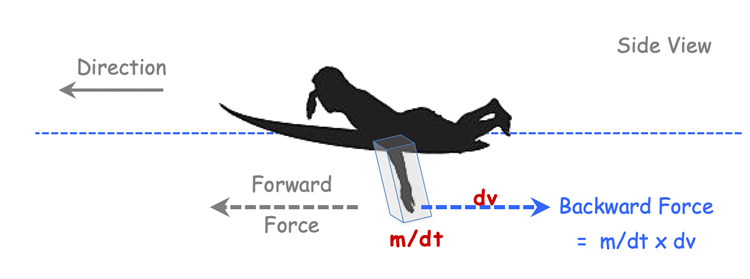
More precisely, a surfer's arms accelerate a mass of water each second (m/dt) backward to a velocity (dv), which creates a backward force (Force BACK = ma = m/dt x dv).
The reaction generates an equal and opposite forward force, as described by the equation:
Force Forward = m/dt x dv
The swimmer's efficiency at generating the optimal forward force depends on finding a balance between 'm/dt' and 'dv' and directing the fluid flow directly backward (not sideways or downward).
The best techniques to swim faster include:
a) Minimizing drag: the surfboard minimizes the drag from the surfer's body, as compared to a swimmer;
b) Maximizing the Coanda effect;
c) Optimizing the angle-of-attack (AOA);
d) Maximize 'm/dt' and 'dv', and therefore, the force generated (Force = m/dt x dv). For example, flippers help because they increase 'm/dt' with each kick;
Where:
m = Mass of water passed through and pushed back;
m/dt = Mass flow rate;
dt = Change in time (per second);
dv = Change in velocity (v) of the water;
v = Velocity of the water displaced back by the fish;
a = dv/dt = Acceleration;
Force = ma = m x dv/dt = m/dt x dv
Force = ma = m x dv/dt = d(m/v)/dt
Momentum = mv
The physics described above is summarized by the equations:
Force BACK = ma = m/dt xdv (1)
Force BACK = Force FORWARD (2)
Equations (1) and (2) can be combined as follows:
Force BACK = Force FORWARD = m/dt x dv (3)
Or simply:
Force FORWARD = m/dt x dv (4)
Units:
N = kg/s x m/s
In Equation (4), the change in velocity of the air is expressed as 'dv,' and not as acceleration ('dv/dt') because this action is due to a one-off force (impulse) from the wing.
It is not time-dependent.
Whereas the mass of air flown through by the wings is time-dependent and is therefore expressed as 'm/dt.'
The Newtonian explanation is not the prevailing method used by biologists to explain the physics of swimming, which includes the elongated-body theory and the resistive force theory (RFT) for undulatory locomotion.
B. Transfer of Momentum
There is no net gain or loss of momentum, energy, and mass in this process of generating a forward force.
Momentum and kinetic energy is transferred from the swimmer to the water by accelerating the water backward.
Force BACK = ma = d(mv/dt) (5)
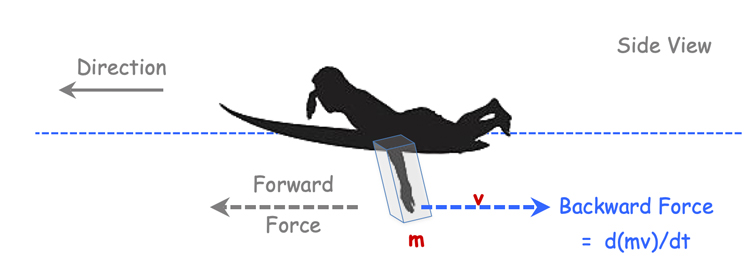
Combining equations (2) and (5) allows the forward force to be expressed as the change in momentum of the water:
Force BACK = Force FORWARD = d(mv)/dt (6)
Or simply:
Force FORWARD = d(mv)/dt (7)
Units:
N = (kg x m/s) / s
C. Two Newtonian Equations for Swimming
The analysis above provides two Newtonian methods and equations to calculate the forward force generated by a wing:
Force FORWARD = ma = m/dt x dv (mass flow rate) (4)
Force FORWARD = ma = d(mv) / dt (momentum theory) (7)
Both equations (4) and (7) are based on Newton's Second Law of Motion (Force = ma).
Both are correct and produce the same values but express the same thing slightly differently.
4. Riding a Wave
A. The Physics of Riding a Wave
Surfers riding a wave generate speed by taking advantage of the water ascending from the wave's trough.
Surfing creates two key forces.
A surfer riding a wave is merely maintaining their speed toward the beach relative to the wave.
A surfer riding a wave and taking a direct line to the beach is not moving relative to the wave. A surfer cannot arrive at the beach much before the wave.
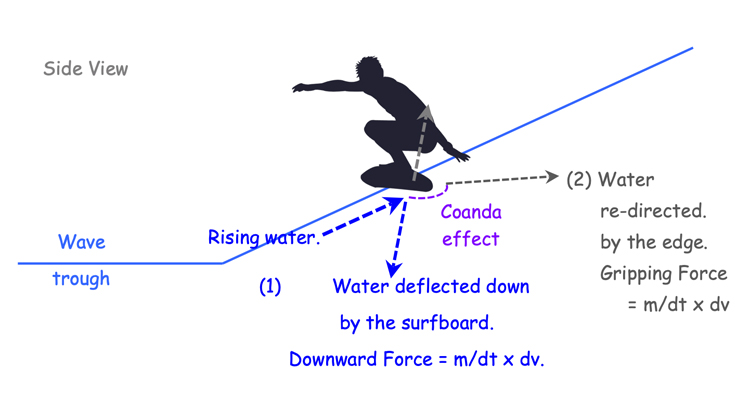
Two enigmas are described:
The enigmas are that the surfer riding a wave can travel laterally across the wave at speeds several times faster than the speed of the wave and that the water appears to grip the surfboard, sucking it downward.
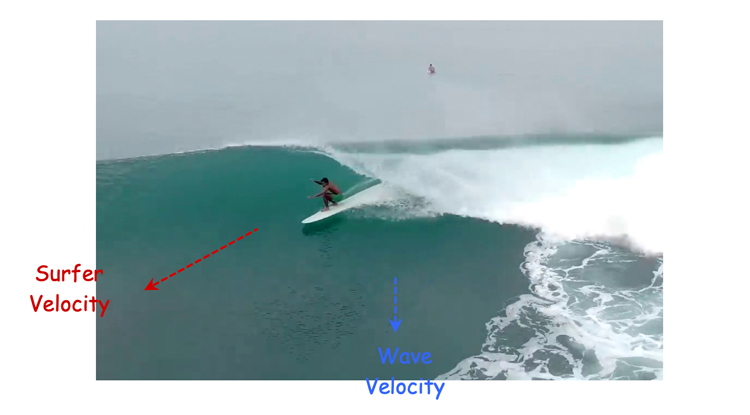
Two key water flows create two key forces that act on a surfboard riding a wave:
1. The downward force;
2. The gripping force;
These forces are described below.
Downward Force
In short, the wave pushes the surfboard upwards.
The surfboard uses this force to gain velocity and move laterally along the wave.
The flat part of the surfboard in contact with the wave pushes a mass of the water down each second (m/dt) at a velocity relative to the surfer (dv).
This action creates a downward force (Force = m/dt x dv). The reaction generates an equal and opposite force that pushes the surfer upwards.
To avoid being pushed up the wave toward the crest by the upward force.
The surfer points the nose of the surfboard diagonally down the wave, which accelerates the surfboard in that direction.
The greater the downward and upward forces generated, the faster the surfboard can travel along the wave while maintaining its relative position on the wave.
However, if the surfer travels too fast, they could outrun the wave.
'm/dt' will depend on the surface area of the board that is in contact with the wave and the speed of the board.
There is a positive feedback loop: the faster the surfboard is going, the higher the 'm/dt' and 'dv' are.
This increases the forces generated (Force = m/dt x dv) and the faster the surfboard can travel along the wave.
In principle, the positive feedback loop is similar to a boat sailing into a strong wind. The closer to the wind that the boat sails, then the faster it travels.
As the boat sails into the wind, 'm/dt' and 'dv' increase, increasing the force generated (Force = m/dt x dv).
In turn, this explains why a surfer can control their speed by altering the surface area of the surfboard in contact with the water.
This helps the surfer avoid outrunning the wave.
The surfer controls the angle and direction of the forces generated to provide stability and maneuverability.
Gripping Force
When riding a wave, the curvature on the edge of a surfboard in contact with the wave redirects some of the water flow along its original upward trajectory due to the Coanda effect.
As demonstrated by the spoon experiment above, this helps grip the surfboard to the wave.
For the surfboard riding a wave, the direction of the water flow is upward. This aspect is the reverse of the downward water flow in the spoon experiment.
The physics between the surfboard and spoon is the same.
The greater the curvature on the edge of a surfboard, then the stronger the Coanda effect. Then, the better that the surfboard grips the water.
The gripping force is described by the same Newtonian equation (Force = m/dt x dv).
The 'm/dt' and 'dv' components of the gripping force are different from those of the downward force above.
The mass and velocity of the water redirected by the Coanda effect are different from the mass and velocity of the water deflected by the surfboard.
Similar to the downward force, the faster the surfboard is going, the greater 'm/dt' and 'dv,' and the stronger the Coanda effect.
The Coanda effect explains noseriding and how surfers can stand in seemingly unbalanced positions when riding a wave.
B. Additional Comments
To catch a wave, a surfer needs to have a similar speed to the wave.
The ascending water at the front of a cresting wave helps accelerate the surfer forward from the wave trough.
If the surfer hasn't accelerated to the wave's speed by the time the crest reaches them, then the surfer fails to catch the wave.
The wave is pushing the surfboard forward with it as it travels toward the beach.
This means that:
a) The greater the surface area of the surfboard in contact with the wave, the greater the force exerted by the wave against the board (Force = Pressure x Area);
b) For a cresting wave, the closer the surfboard is to the top of the wave, the stronger the force on the board from the water circulating forward. Conversely, the closer to the trough of the wave, the least exposure to the water circulating forward;
c) For a cresting wave, the steepest point is where the water rises the fastest. Therefore, this point provides the greatest force from the wave on the surfboard;
d) If the surfer riding a wave descends or ascends the wave, then they gain/lose speed and kinetic/potential energy due to gravity;
A surfer riding a wave gains momentum from the wave as it moves forward. The surfer is being pushed upwards by the wave.
C. Angle-of-Attack (AOA)
The AOA is the angle between the surfer's arms swimming - or the surfboard when surfing - and the direction in which the water is pushed.
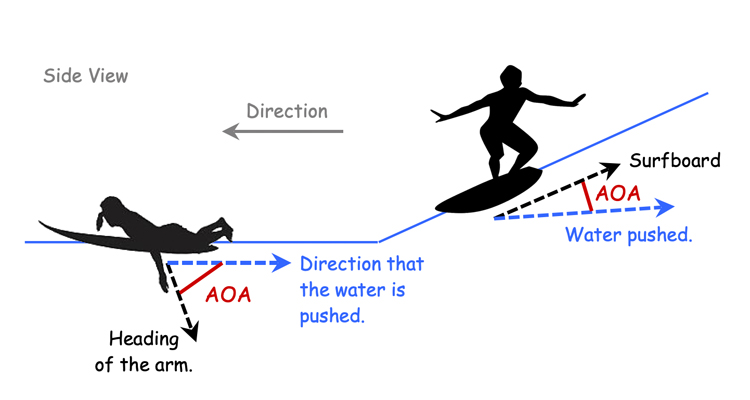
The AOA between the surfer's arms and the direction in which the water is pushed varies constantly as they move their arms through the water.
The key point is that the AOA of the surfboard riding a wave is often small. The surfboard changes the direction that the water is moving very little.
Again, this is similar to the small AOA that airplane wings need to generate lift in a stable cruise flight.
The AOA of the surfboard affects the direction in which the water is displaced and, therefore, the direction in which the forces are generated.
The AOA also affects 'dv' and, therefore, the force generated (Force = m/dt x dv).
This means that the surfer can use the AOA to control their position on the wave.
For example, a surfboard with a small AOA will generate a small force from the wave in the direction of the trough.
If the force generated is insufficient to support the surfer's weight, then it will accelerate downward due to gravity and descend the wave toward the trough.
Conversely, a large AOA increases the force generated by the surfboard from the wave in a direction away from the trough.
If the force generated exceeds the surfer's weight, then the surfboard will ascend up the wave toward the crest (away from the trough).
This is done while the surfer remains facing toward the beach.
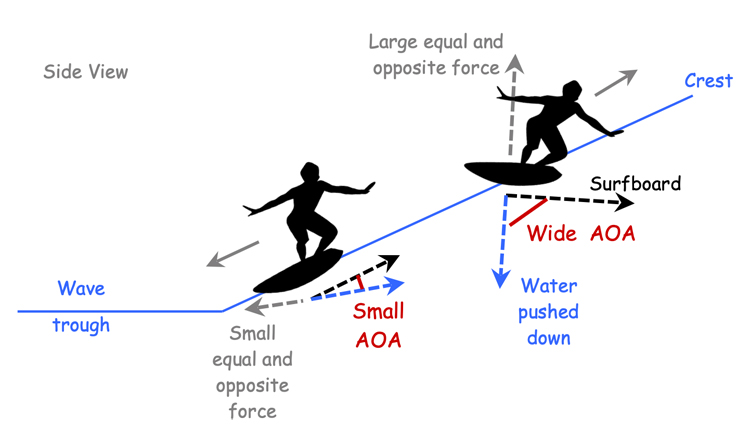
5. Nose Riding
A. Riding the Nose of the Surfboard
The Coanda effect explains nose riding and why the surfer appears to be suspended when in a barrel.
At first glance, nose riding and the surfer's position surfing a barrel appear illogical, as the surfer is standing in an unbalanced position on the surfboard compared to its center of gravity when not riding a wave.
It appears that the surfboard should be unbalanced and tip over, but it doesn't.
Nose riding illustrates how the water grips the edges of the surfboard due to the Coanda effect.
This pulls the surfboard toward the wave, as explained above.
Nose riding and these other positions require a minimum of speed.
It typically cannot be done on a shallow wave or at a low speed. It cannot be done if the surfboard is stationary.
The force produced by the Coanda effect to grip the surfboard to the water depends on 'm/dt' and 'dv.'
In turn, this depends on the speed, length, and curvature of the edges of the surfboard.
Longboards are favored for noseriding because they provide longer edges to grip the water, therefore generating a greater force.
Noseriding typically involves both edges of the surfboard in contact with the water.
Therefore, this will generate a stronger Coanda effect compared to only one edge being in contact with the wave.
B. Nose-Riding: Other Explanations
How the water grips the board to enable nose riding is typically explained by:
a) The surface tension of the water with the surfboard;
b) The weight of the water on the back of the board;
c) Fluid mechanics (i.e., hydrodynamics and Bernoulli);
d) Buoyancy of the surfboard;
None of these explanations are satisfactory or accurate. At best, they are only partially correct.
Nonetheless, these are not the determining factors that explain how a boat grips the water.
None have been proven by experimentation.
There are no calculations based on the accepted physics formula that support these explanations.
It is beyond the scope of this paper to discuss these other explanations in any detail.
There appears to be agreement among surfers that nose riding is possible because a force is pulling the rear of the surfboard downward.
However, there is no agreement on the physics involved.
C. Leverage, Pivots and Moments: The Basics
Leverage can create torque (or moment) around a pivot, which amplifies or dilutes a force, depending on the perspective.
Force is measured in 'N' while leverage is measured in 'Nm.'
Torque (or the moment) is calculated using the distance from the pivot multiplied by the force, as described by the equation:
Moment (Nm) = Force (N) x distance (m)
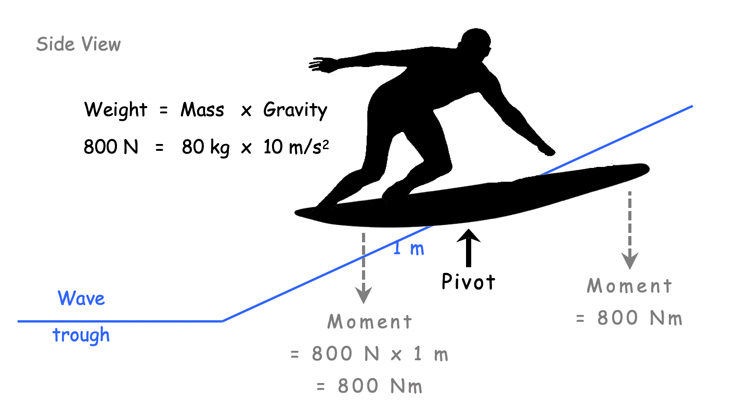
For example, the leverage of an 80-kilogram surfer standing on the nose of a surfboard and one meter from the pivot point on the water produces a moment of about 800 Nm.
This calculation assumes gravity to be about 10 m/s2.
For the surfboard to maintain its balance on the wave, the 800 Nm moment (A) due to the surfer noseriding (calculated above) requires a compensating 800 Nm moment (B) on the opposite side of the pivot at the back of the surfboard.
This compensating 800 Nm moment (B) comes from the Coanda effect gripping the surfboard.
This is a relatively large force.
6. Discussion of Results
In contrast to other theories, Newtonian physics provides a simple and easy-to-understand explanation of surfing that fits with what is observed in practice.
It is puzzling that no one has attempted to use Newtonian physics to explain surfing previously.
It is also puzzling that few surfers appear concerned that this is worth solving, being content to learn and progress by trial and error.
7. Conclusions
Newtonian mechanics explains the physics of surfing, which is consistent with other sports such as gliding and sailing.
In particular, the Newtonian-based approach solves the enigmas:
a) How a surfer can surf at speeds several times faster than the wave that they are riding;
b) How the water grips the surfboard due to the Coanda effect;
Words by Nicholas Landell-Mills
